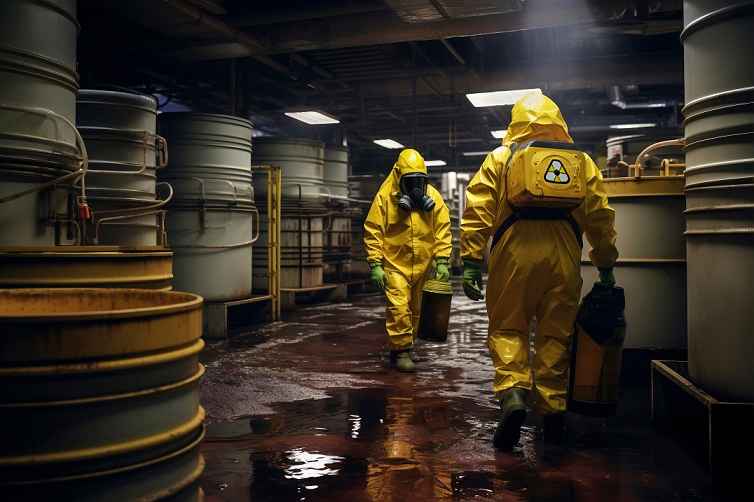
Protect Your Home: Best Practices for Storing Flammable Liquids Safely
When it comes to keeping your home safe, few things are as crucial as how you handle flammable liquids. From the paint in your garage to the cleaning supplies under your sink, these everyday items can pose significant risks if not stored properly. Imagine a spark igniting a careless spill or an accidental leak creating a hazardous situation—scary, right? But fear not! With just a little knowledge and some proactive measures, you can protect your home and loved ones from potential disasters.
Introduction to the importance of storing flammable liquids safely
Your home is your sanctuary, a place of comfort and safety. But lurking in the corners or tucked away in cabinets might be substances that pose hidden dangers: flammable liquids. From paints to cleaning supplies, these everyday items can ignite unexpectedly if not stored properly. Understanding the importance of safe storage practices is crucial for protecting your loved ones and belongings from fire hazards.
Imagine a situation where a small spill leads to an uncontrollable blaze. The reality is that improper storage can create risks you may not even consider until it’s too late. That’s why taking proactive measures to ensure flammable liquid storage isn’t just wise—it’s essential for every homeowner.
Let’s explore how you can keep your home safe by following best practices when handling these potentially dangerous substances.
Understanding the properties of flammable liquids
Flammable liquids are substances that can ignite easily and burn rapidly. They have unique properties that make them particularly hazardous if not handled correctly.
One key characteristic is their flash point, which is the lowest temperature at which they produce enough vapor to form an ignitable mixture with air. Liquids like gasoline and alcohol can catch fire at surprisingly low temperatures, making proper storage essential.
Additionally, these liquids often release vapors that are heavier than air. These vapors can accumulate in low areas, creating a risk of explosion or fire if exposed to sparks or flames.
Understanding density also plays a role. Some flammable liquids may float on water while others sink, affecting how spills should be managed.
Awareness of these properties helps ensure safety by guiding effective storage practices and emergency responses when dealing with flammable materials.
Potential dangers and risks associated with improper storage
Improper storage of flammable liquids can lead to catastrophic consequences. One small oversight may ignite a fire, threatening lives and property.
Vapors from these substances can accumulate quickly in enclosed spaces. A single spark or flame could trigger an explosive reaction, causing extensive damage.
Inadequate containment might also result in spills. These spills not only create immediate hazards but can contaminate soil and groundwater as well.
Additionally, improper labeling increases the risk of accidents. Without clear identification, anyone could mistakenly mishandle dangerous materials.
The psychological toll cannot be overlooked either; constant anxiety over potential disasters takes its toll on homeowners’ peace of mind.
Understanding these risks is crucial for implementing effective safety measures at home. Keeping your environment secure begins with responsible management of flammable liquids.
Best practices for storing flammable liquids in your home
Choosing the right storage containers is crucial for flammable liquid storage. Opt for approved, sturdy containers made from materials designed to resist corrosion and impact. This simple choice can make a significant difference in safety.
Proper labeling helps everyone in your home identify hazardous materials quickly. Clearly mark each container with its contents and any warnings to prevent accidental misuse.
Organization also plays a vital role. Keep flammable liquids together, away from other household items that might react adversely. A designated shelf or cabinet reduces risk and enhances accessibility during emergencies.
Ensure these liquids are stored in a well-ventilated area to prevent harmful vapors from accumulating. Fresh air circulation significantly lowers fire risks associated with fumes.
Finally, always keep flammable substances away from heat sources like stoves, heaters, or electrical appliances that could ignite them unexpectedly. Taking these precautions protects you and your loved ones effectively.
-
Choosing the right storage containers
When it comes to flammable liquid storage, selecting the right containers is crucial. Look for materials that are specifically designed to handle hazardous substances. Steel and high-density polyethylene (HDPE) are popular choices due to their durability.
Make sure the containers have a secure sealing mechanism. This prevents leaks and minimizes vapor release, both of which pose significant risks in case of an accident.
Size matters too; choose containers that suit your needs without being overly large or small. Overfilling can lead to spills, while insufficient capacity may leave you with excess flammable liquids elsewhere.
Don’t forget about compliance with safety regulations specific to your area. Always check if there are standards governing container types for storing flammable liquids; adhering to these guidelines enhances safety significantly.
-
Proper labeling and organization
Proper labeling is crucial when it comes to flammable liquid storage. Clear and visible labels help everyone in your home identify hazardous materials quickly. Use bold lettering and include the type of liquid, along with any potential hazards associated with it.
Organizing your storage area can further enhance safety. Group similar substances together, ensuring that incompatible liquids are stored apart. This reduces the risk of dangerous reactions in case of accidental spills.
Investing in color-coded labels can simplify identification even more. For instance, red could signify highly flammable substances, while yellow indicates cautionary products.
Regularly check your inventory for expired or unused items as well. Disposing of these properly helps maintain a safe environment and ensures that you only keep what’s necessary on hand.
-
Storing in a well-ventilated area
When it comes to flammable liquid storage, ventilation is essential. A well-ventilated area helps disperse any vapors that might escape from containers. This reduces the risk of accumulation and potential ignition.
Consider placing your storage in a garage or a shed with windows or vents. Ensure air can circulate freely around these liquids. Avoid cramped spaces where fumes could linger unseen.
Regular checks on airflow are vital too. If you notice an unusual smell or buildup of vapor, take immediate action by relocating the containers to improve conditions.
Don’t forget about humidity levels either; high humidity can affect some chemicals’ stability and increase risks. Maintaining a dry environment complements proper ventilation for safer storage practices.
-
Keeping away from heat sources and ignition points
When it comes to flammable liquid storage, location is everything. Keeping these substances away from heat sources is crucial for safety. Heat can ignite vapors, leading to dangerous situations.
Identify all potential ignition points in your home. This includes furnaces, water heaters, and stoves. Even small appliances like hairdryers or space heaters can pose a risk if they’re too close.
Consider the environment where you store these liquids. A garage may seem like a convenient place, but if it’s near any heating equipment, it’s not ideal. Choose a cool area with minimal temperature fluctuations.
Regularly inspect your storage area for any changes that could introduce new hazards. Awareness of your surroundings goes a long way in preventing accidents related to flammable materials stored nearby heat sources.
Steps to take in case of a spill or fire
When dealing with a spill or fire involving flammable liquids, swift action is crucial. First, remain calm and assess the situation quickly.
If a spill occurs, immediately contain it if safe to do so. Use absorbent materials like sand or special pads to soak up the liquid. Always wear protective gear during this process.
In case of flames, prioritize your safety. Evacuate everyone from the area without hesitation.
Have an emergency preparedness plan in place before incidents happen. Knowing designated escape routes can save precious time when lives are at stake.
Once you’re safely away from danger, call emergency services right away. Provide clear details about the situation so they can respond effectively.
Remain at a safe distance until help arrives and avoid re-entering hazardous areas until it’s declared safe by professionals.
You may also read (using smart home devices protect your hom)
-
Emergency preparedness plan
An emergency preparedness plan is essential for every household. It ensures that everyone knows what to do if a flammable liquid incident occurs.
Start by identifying potential hazards in your home. Determine where you store these liquids and assess the risks associated with each location.
Create clear procedures for responding to leaks, spills, or fires. Assign roles to family members so they understand their responsibilities during an emergency.
Regularly practice these scenarios through drills. Familiarity can make all the difference when panic sets in.
Keep emergency contact numbers easily accessible. This includes local fire departments and poison control centers.
Consider investing in safety equipment like fire extinguishers and first-aid kits as part of your preparedness resources. Ensure all family members know how to use them effectively.
Review this plan periodically, making updates as necessary based on changes within your home or lifestyle.
-
Evacuation procedures
When it comes to evacuation procedures, clarity is essential. Make sure everyone in your home knows the fastest way out. Designate primary and secondary exits for different scenarios.
Practice drills regularly so that everyone feels confident. Familiarize yourself with every family member’s role during an emergency. Children should know how to alert adults if a fire occurs.
Create a safe meeting point outside your home where everyone can gather after evacuating. This ensures no one gets left behind or goes back inside unnecessarily.
Consider keeping essentials by the exit—like phones, keys, or emergency contacts—so you can grab them quickly during an urgent situation.
Above all, stay calm and focused when it’s time to leave. Panic can lead to mistakes; knowing exactly what to do makes all the difference in ensuring everyone’s safety.
-
Contacting emergency services
When a spill or fire occurs, contacting emergency services is crucial. Your safety and the safety of those around you should always come first.
Make sure to call your local emergency number without delay. Provide clear and concise information about the situation. Describe what type of flammable liquid is involved, if known, as this helps responders prepare adequately.
Stay calm during the call. Panic can lead to miscommunication. Once you’ve contacted them, follow their instructions carefully while keeping a safe distance from the incident.
If possible, inform neighbors or nearby individuals about the danger so they can evacuate or take necessary precautions too.
Remember that every second counts in emergencies involving flammable liquids; do not hesitate to reach out for help when needed.
Alternative options for storing flammable liquids
When it comes to flammable liquid storage, you might consider professional facilities. These specialized environments are designed with fire safety in mind. They adhere to strict regulations and provide controlled conditions that minimize risk.
If keeping products at home feels risky, why not think about disposal? Many communities offer safe disposal programs for unused or expired flammable liquids. This ensures they don’t sit around your house waiting for a potential accident.
Another option is the use of chemical distributors who can handle excess stock responsibly. By choosing these alternatives, you’re taking proactive steps toward maintaining a safer living space while still managing necessary substances effectively.
-
Professional storage facilities
For those with extensive flammable liquid inventories, professional storage facilities can be a lifesaver. These specialized environments are designed to meet strict safety standards. They provide secure and regulated spaces that minimize the risk of accidents.
Using a facility means your substances are stored in fire-resistant containers. The staff is trained to handle hazardous materials safely. This expertise ensures compliance with local regulations, which can be complex for homeowners.
Additionally, these facilities often feature advanced fire suppression systems. This extra layer of protection adds peace of mind when it comes to your valuable items.
Accessing professional storage also frees up space at home. It allows you to organize your living area while ensuring that flammable liquids are handled properly and securely away from potential hazards.
-
Disposing of unused or expired products safely
Disposing of unused or expired flammable liquids is crucial for maintaining a safe environment. Many homeowners underestimate the risks associated with improper disposal methods.
First, don’t simply pour these substances down the drain or toss them in the trash. These actions can pose serious environmental hazards and legal issues. Always check local regulations regarding hazardous waste disposal.
Consider taking advantage of community hazardous waste collection days. Many municipalities host events where you can drop off unwanted chemicals safely.
If that’s not an option, look for specialized disposal facilities near you. They are equipped to handle such materials and ensure they are processed correctly without harming the environment.
Educating yourself about safe disposal practices helps protect your home and community from potential dangers associated with flammable liquids. It’s a small step that contributes significantly to overall safety standards around us.
Conclusion: Importance of following these best practices
Storing flammable liquids safely is not just a precaution; it’s essential for protecting your home and loved ones. By understanding the properties of these substances, you can minimize risks and potential dangers associated with improper storage. Implementing best practices such as choosing the right containers, labeling clearly, maintaining proper ventilation, and keeping items away from heat sources will significantly reduce the likelihood of accidents.
Being proactive about emergency preparedness enhances safety further. Having an evacuation plan in place and knowing how to respond quickly in case of a spill or fire can save lives. Additionally, exploring alternative options like professional storage facilities or responsibly disposing of unused products helps maintain a safe environment.
By following these guidelines diligently, you are taking significant steps towards ensuring that your home remains secure from the hazards posed by flammable liquids. Prioritizing safety today leads to peace of mind tomorrow.
You may also read (top 5 firearm storage methods)


